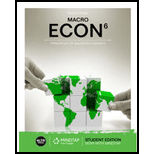
Sub-part
A
The ways in which a $10,000 deposit into a checking account would initially affect a bank’s assets and liabilities:
Concept Introduction:
The Federal Reserve and banking system are responsible for the creation of money in the economy. The first step of this money creation process starts when the Federal Reserve injects money in the economy by buying bonds. This money is stored in a bank. Then, the bank would keep the
Sub-part
B
The ways in which a bank makes a loan of $1000 by establishing a checking account for $1000 would initially affect a bank’s assets and liabilities:
Concept Introduction:
The Federal Reserve and banking system are responsible for the creation of money in the economy. The first step of this money creation process starts when the Federal Reserve injects money in the economy by buying bonds. This money is stored in a bank. Then, the bank would keep the required reserves with themselves, and lent the remaining excess reserves. These excess reserves will then be stored with some other bank and the other bank would also keep the required reserve and make a loan for the remaining amount. These excess reserves keep flowing in the economy, thus, creating money at every stage.
Sub-part
C
The ways in which a loan of $1000 established by checking account for $1000 is spent would initially affect a bank’s assets and liabilities:
Concept Introduction:
The Federal Reserve and banking system are responsible for the creation of money in the economy. The first step of this money creation process starts when the Federal Reserve injects money in the economy by buying bonds. This money is stored in a bank. Then, the bank would keep the required reserves with themselves, and lent the remaining excess reserves. These excess reserves will then be stored with some other bank and the other bank would also keep the required reserve and make a loan for the remaining amount. These excess reserves keep flowing in the economy, thus, creating money at every stage.
Sub-part
D
The ways in which a bank should write off a loan would initially affect a bank’s assets and liabilities:
Concept Introduction:
The Federal Reserve and banking system are responsible for the creation of money in the economy. The first step of this money creation process starts when the Federal Reserve injects money in the economy by buying bonds. This money is stored in a bank. Then, the bank would keep the required reserves with themselves, and lent the remaining excess reserves. These excess reserves will then be stored with some other bank and the other bank would also keep the required reserve and make a loan for the remaining amount. These excess reserves keep flowing in the economy, thus, creating money at every stage.
Trending nowThis is a popular solution!

Chapter 14 Solutions
MindTap Economics, 1 Term (6 Months) Printed Access Card for Mceachern's ECON MACRO, 6th
- Will the amount of new loan be affected if the additional $400,000 was deposited in the Second National Bank?arrow_forwardWould you consider deposits of money in banks and similar situations, such as savings deposit and current account deposits, contracts of depositum or mutuum?arrow_forwardExplain the answer and/or show any calculation to prove the answer. The Bank Rakyat had several large withdrawals and its reserves have fallen below its required reserves. Other banks are unwilling to lend it money, so it has turned to the emergency lending division of the Bank Negara Malaysia for an overnight loan. What is the name of the interest rate this bank will be charged for an overnight loan from the Bank Negara?arrow_forward
- Will the additional $400,000 which was deposited in the Second National Bank affect the new loan?arrow_forwardIf $2,000 is withdrawn from the bank by a customer, the bank's Assets and liabilities decrease Assets rise Liabilities decrease and assets rise Assets decrease and liabilities risearrow_forwardNote: Don't use chat botarrow_forward
- By law, banks are allowed to lend an amount equal to their Group of answer choices deposits required reserves loanable funds excess reservesarrow_forwardYour friend Sarah borrows money from her bank to buy a car. Explain to her the transactions in which the bank sets up the loan, and why the loan involves an increase in the money supply.arrow_forwardAs a lender/depositor, how would you compare time to demand deposits? Demand deposits are more liquid, but time deposits pay a higher interest rate Demand deposits are more liquid, but time deposits pay a lower interest rate Demand deposits are less liquid, but time deposits pay a higher interest rate Demand deposits are less liquid, but time deposits pay a lower interest ratearrow_forward
- A commercial bank has $80000 in deposits. There are $6,000 in actual resources, of which $2,000 are excess reserves. Describe the Rate of return.arrow_forward11. The monies that are very liquid such as cash, checkable (demand) deposits, and traveler's checks are considered to bearrow_forwardBuying a cup of coffee with a dollar bill represents the use of money as aarrow_forward


 Exploring EconomicsEconomicsISBN:9781544336329Author:Robert L. SextonPublisher:SAGE Publications, Inc
Exploring EconomicsEconomicsISBN:9781544336329Author:Robert L. SextonPublisher:SAGE Publications, Inc Principles of Economics 2eEconomicsISBN:9781947172364Author:Steven A. Greenlaw; David ShapiroPublisher:OpenStax
Principles of Economics 2eEconomicsISBN:9781947172364Author:Steven A. Greenlaw; David ShapiroPublisher:OpenStax






